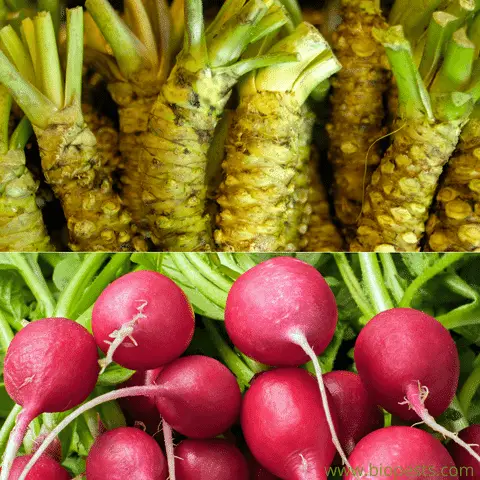Horseradish and radish have very similar names, and telling the two apart can get confusing, with some people using their names interchangeably. But are these two the same thing, or are they different plants?
Horseradish and radish are two different plants, but they are from the same plant family. They are both root vegetables, but radish is small and round and comes in many colors, while horseradish is long, thick, and is white. They both have a strong flavor, but horseradish is spicier.
What are the differences between horseradish and radish? What are the health benefits of eating radish and horseradish? Are there any risks to eating these two vegetables? We will discover all there is to know about radishes and horseradish in this article!
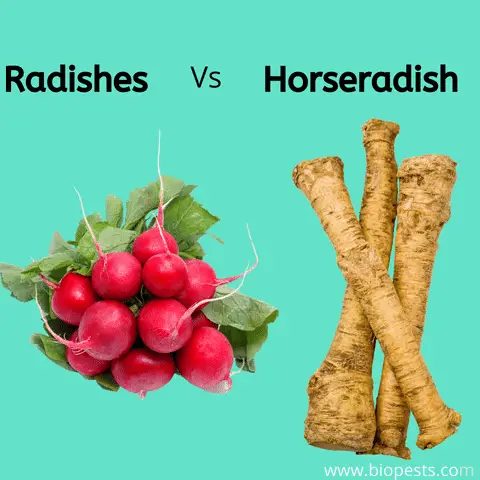
Horseradish Vs. Radish
Horseradish and radish have been used in cooking for decades, and many people have come to enjoy their unique flavors. You can use these two vegetables in many different dishes, with horseradish mostly used as a condiment and radish used as an ingredient in fresh salads.
Many people confuse radish and horseradish due to their similar names, with some people using their names interchangeably, but are these two vegetables the same thing? Let’s go through everything you should know about these two vegetables to help you understand them better.
Horseradish Defined
Horseradish is a lovely root vegetable mainly used as a condiment, but horseradish can also be used in cooking to add a strong flavor to your food. Horseradish has a very pungent odor and taste that is extremely distinct from the root vegetable.
Horseradish is a perennial plant from the Brassicaceae family and is closely related to mustard plants; some people would describe it as tasting somewhat like mustard.
Horseradish has been used for medicinal purposes throughout history, and today it’s still used as an ingredient in some alternative medicines. Horseradish originated in western Asia and southeast Europe, but you can now find horseradish grown worldwide.
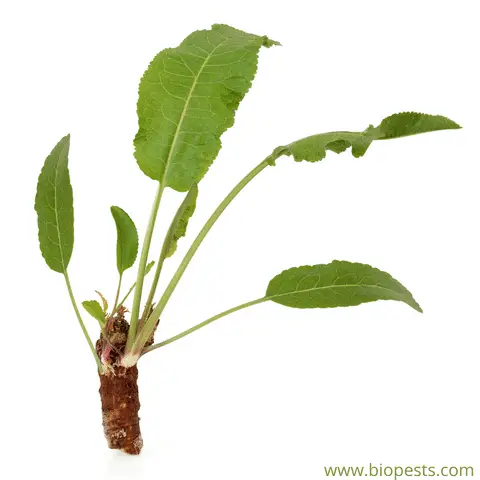
Radish Defined
Radish is also a lovely root vegetable, but it is mainly used as an ingredient in salads to add some crunch or eaten by itself instead of as a condiment. Radish also has a pungent odor and taste, but it’s not as intense as horseradish.
Radish is also a part of the Brassicaceae plant family, so it is related to horseradish, but it’s not the same plant. Radish originated in Asia but has now spread and is grown in most countries worldwide.
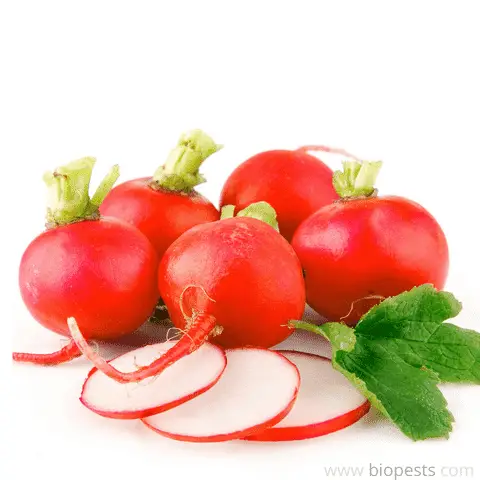
How Are Radishes And Horseradish Different?
So, horseradish and radish are from the same plant family and seem to have a lot in common, but this doesn’t mean they are the same. Horseradish and radish have many differences that offset their similarities and make them their own root vegetable.
If you are trying to understand the differences between horseradish and radish, this section will help you clarify the differences. So, let’s go through them to help you understand both vegetables better.
The Appearance Of The Vegetables
The first difference we will go through is the appearance of these root vegetables, as they look very different. Horseradish is a plant that grows to about 5 feet tall and has lovely bright green unlobed, hairless leaves.
This root vegetable is harvested for the plant’s root, the part we eat. This root is white, large, and tapered. It has very little smell until it’s cut open and used in cooking or for condiments.
Radishes, on the other hand, are biennial or annual plants grown for their swollen tap roots, which is what we eat. However, the leaves and stems of radish plants are also edible and are generally used as leafy greens in salads.
The roots, or radishes, come in various colors, from pink, white, yellow, green, and purple on the outside, with the root’s flesh being white. Radishes are small and round, and their plants can vary in size depending on which variety of radish you grow.
The Nutrition Of The Vegetables
So, horseradish and radish are very different in appearance, but that’s not the only difference between the two root vegetables. There are also variations in the nutrition of each root vegetable. Even though both vegetables are low in calories, horseradish has a higher calorie count than radish.
Horseradish is higher in carbohydrates, sugar, and fiber than radish. Horseradish can cover about 9% of your daily fiber intake. Horseradish and radish are low in protein, with both only coving about 2% of your daily required protein intake.
Both have a great amount of folate and vitamin C, but horseradish has higher levels than radish. When compared to radish, horseradish has more calcium, magnesium, and sodium, with its sodium levels accounting for 18% of your daily intake.
So, radish and horseradish are good for you and offer great nutritional value, but horseradish is slightly better.
Taste Of The Vegetables
The last area we will go through is the difference in taste between horseradish and radish. Radishes can be consumed raw or cooked, and they have a very distinct zesty, crisp, and slightly spicy flavor when eaten raw.
When you cook a radish, the taste becomes milder and slightly sweeter, which can make the radish easier to eat for some people. The different radish varieties also have different flavor strengths, some milder in flavor than others.
Horseradish has a very intense flavor, especially when eaten raw. The flavor is spicy and can bring tears to your eyes if you eat it by itself. The flavor is still spicy when horseradish is cooked or made into a condiment, but it won’t cause your eyes to tear up.
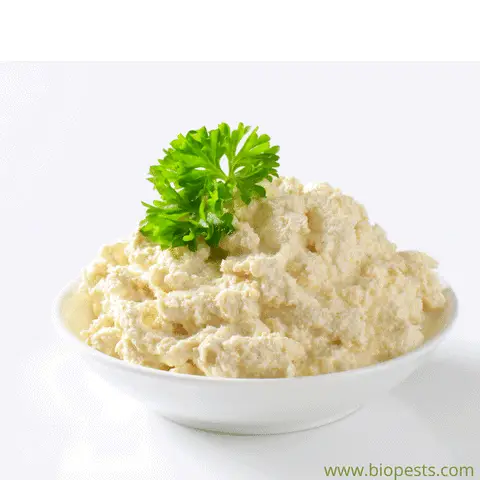
Health Benefits Of Radish And Horseradish
Even though horseradish and radish are different plants, they still have similar health benefits that are important to know. Horseradish and radish are foods you should add to your diet, as they are nutritious and can help you sustain your health in the long run. Let’s go through a few health benefits of eating horseradish and radish.
They Help With Inflammation
Radish and horseradish both have some excellent anti-inflammatory properties to them. These root vegetables can help keep swelling in the body down, which helps the body to recover more easily from whatever is affecting it.
The anti-inflammatory properties of radish and horseradish have similar effects to some NSAID medications like ibuprofen and aspirin.
Both Are Filled With Antioxidants
Horseradish has some excellent antioxidant effects when you eat it. These antioxidants help reduce the superoxides and oxidants in your body. This is important as these superoxides and oxidants can help cause certain diseases like cancer.
Radishes also have a relatively high amount of antioxidants, which can help fight off oxidation caused by cancer and other diseases in the body.
Both Can Help Prevent Cancer
The leaves of radish plants have some anti-tumor that can help kill off cancer cells within the body. Horseradish can have an antimutagenic effect on the body.
This means that when there is a mutation in a human cell that causes cancer to develop in the body, the antimutagenic properties of horseradish can help eliminate the oxidative agents in the body that caused the mutation. This can help prevent further growth of the cancer cells.
Both Vegetables Help With Cardiovascular Health
Radishes can help keep your cardiovascular system healthy when you eat the root vegetable regularly. Due to the anti-inflammatory and antioxidant properties in radishes, they can help prevent damage to blood vessels in the body.
Radishes also contain anti-hypertensive properties that can help decrease blood pressure, making them a powerful food for people suffering from high blood pressure.
Horseradish also has some anti-inflammatory and antioxidant properties that can help reduce the risk of you developing other cardiovascular diseases, like heart disease.
Radishes Can Help Prevent Diabetes
If you consume radish regularly, this could help prevent you from developing diabetes. Radish has great anti-diabetic properties that can help regulate your body’s absorption of glucose. This root vegetable also has regulatory effects on hormones, meaning it can help regulate blood sugar.
Risks Of Consuming Horseradish And Radish
Even though radish and horseradish are excellent foods to have in your diet and they are very nutritious, for some people, they can have some negative side effects when eaten.
These negative effects are rare, but you should look out for them to be sure you aren’t affected by them. Let’s go through the risks of eating too much radish and horseradish.
Horseradish Can Cause Problems In the Urinary System
If you consume horseradish in large quantities every day for a long period of time, then this root vegetable can start causing problems with your urinary system. Consuming horseradish in excess for a long time can cause lesions to form in the bladder, which can be painful and affect your health.
Radish Can Affect Thyroid Hormones
If you consume large amounts of radish every day for a long period of time, then this can begin to cause some problems with your thyroid hormones. Eating radish in excess for a long time can mimic the symptoms of iodine deficiency in the body, called hypothyroidism, even though the iodine levels are normal.
Conclusion
Horseradish and radish are very different plants but belong to the same plant family. Radishes are milder in taste compared to horseradish, but they both have a strong flavor that can put some people off.
Radishes and horseradish are very healthy and nutritious foods that you should add to your diet.
However, you should still consume them in moderation, meaning one small portion a day, to help prevent any negative side effects of over-consuming them. Hopefully, this article has helped you understand the difference between horseradish and radish.
If you are a radishes lover, check out these articles!
Why Radishes Get Worms? Tips On How To Solve This Problem
Which Radishes Are The Spiciest? What Makes Them Spicy
Why Do Radishes Taste Like Soil? Here Is Why
Some of the links above are affiliate links, meaning, at no additional cost to you, I will earn a commission if you click through and make a purchase.

